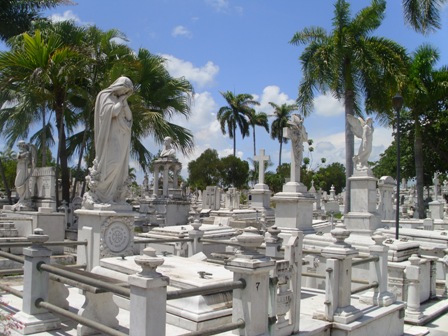Santa Ifigenia Cemetery, Santiago de Cuba Landmark
By Dariela Aquique, Photos: Janis Hernandez

HAVANA TIMES, Sept. 9 — Santiago de Cuba’s monumental cemetery is a must see for visitors to that eastern city. By going there one can have a true encounter with Cuban and universal history.
It occupies an area of 133,000 square meters and is the second largest in Cuba after Havana’s Colon Cemetery. It’s value does not only come from holding the remains of heroes, characters, renowned men and women, but also from its monumentality and magnificence.
Here lie the ashes of José Martí, Cuba’s national hero and independence apostle; as well as those of Carlos Manuel de Cespedes, known in Cuba as the Founding Father; Emilio Bacardi, the City’s Favorite Son, among many other distinguished figures such as Federico Capdevila, the defense attorney of eight medical students who were shot in 1871; Tomás Estrada Palma, the first president of the Republic; Ms Mariana Grajales, who was the mother of the Maceo brothers; and Perucho Figueredo, author of the national anthem.
Among the prestigious artists who have also been buried in this place are Francisco Repilado (Compay Segundo); Pepe Sánchez, creator of the musical style called “trova”; Ñico Saquito, an indispensable songwriter. Santa Ifigenia also holds the remains of Emeritus Archbishop Pedro Meurice Estiú, who recently passed away in Miami.
And a curious fact is that the remains of Francisco Antonmarchí, Napoleon Bonaparte’s last doctor, rest in Santa Ifigenia in the ossuary of the Portundo family vault. He lived in Cuba and died here in 1838, victim of the yellow fever.
Illustrious local families such as the Bacardis, the Bravos, the Correosos or the Portuodos have crypts in this cemetery which stand out for their sculptural value. Likewise, one can admire the funerary monuments to families that played an important part in Cuban history such as the Maceo-Grajales or the País-García, to mention a few.
 At the moment some areas of the cemetery are being refurbished, and although it hasn’t been officially announced the mausoleum for the mortal remains of Fidel Castro is being built here.
At the moment some areas of the cemetery are being refurbished, and although it hasn’t been officially announced the mausoleum for the mortal remains of Fidel Castro is being built here.
Its History
This graveyard, which is over a century old, was founded on April 22, 1868, northwest of Santiago de Cuba. After the urban population grew it had to be moved to the outskirts of the city for sanitary reasons. It was first located where today runs Garzon Avenue, which was called Santa Ana in those days.
Santa Ifigenia Cemetery and Dos Ríos, the place where José Martí was killed in combat, were declared national landmarks on February 7,1937. These two sites mark the beginning and the end of Jose Marti funeral route, from the day that he died on May 19, 1895 to the day that his body was buried in tomb No. 134 in the southern part of the cemetery. The status of national landmark for both places was ratified on May 20, 1979.
Today the mausoleum of Jose Martí is an impressive architectural complex, which is 26 meters high by 86 meter long. It holds an ever-lasting flame and there is a permanent guard which is changed every 30 minutes through a beautiful military ceremony.
The largest funerals in the history of this country have taken place in Santa Ifigenia, where thousands of people have accompanied their beloved ones to their last home. Among such congregations stand out the arrival of the remains of José Martí, the burials of Emilio Bacardi-Moreau, Frank País-Garcia, Compay Segundo, or that of Emeritus Archbishop Pedro Meurice.
Click on the thumbnails below to view all the photos in this gallery. On your PC or laptop, you can use the directional arrows on the keyboard to move within the gallery. On cell phones use the keys on the screen.





























